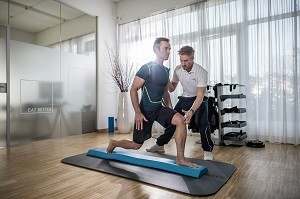Title
Balance-pads: Proprioception creates new applications in therapies and sports
23 January 2018
Since the late 1980s-early 1990s, the healthcare sector has realized that the main cause of back problems in industrialized countries is a specific lack of stimulation. In our affluent society, the stimuli are gone from everyday life. Solid-surfaces, such as tiled floors, paved roads, hardwood floors, etc. underutilize our depth sensitivity. This restricts the communication between our muscles and our nerves, causing our proprioceptors to wither away in the truest sense of the word. The sense of position, tension, and movement in our depth sensitivity is being minimized. The surface sensitivity with the mechanoreceptors which are as responsible for our sense of balance as our middle ear also suffers. The consequences are neuromuscular imbalances, which negatively affect the segmental stabilization of our spine, posture, and sense of balance. This lack of general proprioceptive stimulation makes our backs prone to all sorts of back problems and can cause many other issues.
This form of defective mechanical and neurophysiological strain affects control and regulation processes that should be considered, especially in neuroorthopedics.
In early 2000, the first study results confirmed the lack of proprioception. In rehabilitation, unstable surfaces were increasingly used to treat back patients with great success. This action potential in the proprioceptors that modern life was keeping too low has been increased many times over and the patients' sense of balance has improved. In addition, it helped to create high stimulation of the deep-down muscle fibers that are primarily responsible for stability.
The Balance-pad is an essential tool in contemporary physiotherapy, since it not only makes the therapist's and the patient's work much easier, but also results delivers great results in a relatively short treatment period.
The AIREX® Balance-pad is one of the most effective, yet simplest aids for use in physiotherapy, rehabilitation, preventive treatment both for general patients and competitive athletes. The special waffle and nub structure on the top and bottom offers a slip resistance while also pleasantly stimulating the foot receptors during barefoot balance training. The 6 cm thickness gives the Balance-pad the desired destabilizing properties. The foam gives way and the body is constantly challenged to maintain its balance and stabilize the joints. This means that more muscles are worked more deeply than would be the case if the same exercises were done without a Balance-pad. The control function of the brain is activated and the receptors in the joints and fascia system are increasingly addressed.
The new product line brings a variety of additional options to address the isolation principle as well as global muscle chains. The Solid Balance-pad achieves a milestone. It is not quite as unstable as its predecessors and thus even more sensitive and easier to use, for example, for neurology patients and with people with severely limited sense of balance, as is often the case with older people.
Regular exercise on the Balance-pad trains the neuromuscular system by increasing the demand for a stable posture. It also optimizes the postural system and improves motor skills. Correct application may result in better central motor control due to the quantitative and qualitative increase in afferent input. This means that all of the basic motor skills such as strength, stamina, flexibility, coordination, and balance are stimulated, as well as the mental component, providing a holistic solution, both physically and mentally.

